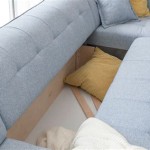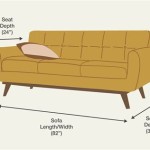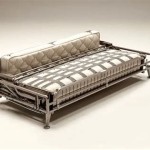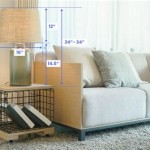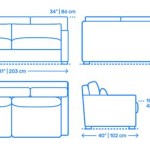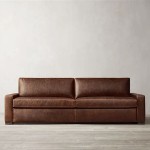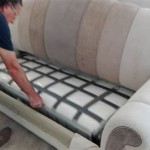Do Sectional Sofas Come Apart? A Comprehensive Guide
Sectional sofas are a popular choice for many homeowners due to their versatility, comfort, and ability to fill large spaces. These sofas, typically composed of multiple independent pieces, offer flexible configurations to suit various room layouts and seating needs. A common question arises among potential buyers and current owners: can sectional sofas be disassembled, either for moving, rearranging, or storage? The answer is generally yes, but the specific method and ease of disassembly can vary greatly depending on the sectional's design and construction.
Understanding how sectional sofas are assembled and the types of connection mechanisms used is crucial for determining whether and how a particular sectional can be taken apart. This knowledge is also vital for successfully reassembling the sofa without causing damage to its structure or upholstery. This article explores the common methods of sectional sofa construction, the connection types used, and considerations for disassembly and reassembly.
Understanding Sectional Sofa Construction
The fundamental characteristic of a sectional sofa is that it comprises multiple individual sections. These sections are designed to be connected to form a larger, cohesive seating arrangement. The individual sections typically include armless chairs, corner pieces, chaise lounges, and sofa sections with arms. The construction of each section generally mirrors that of a standard sofa, featuring a frame (usually made of wood or metal), internal support systems (such as springs or webbing), cushioning materials (like foam and batting), and upholstery.
The primary difference between a sectional section and a standalone sofa lies in the connection points. Sectional sections have designated areas where they can be joined to other sections. These connection points are strategically placed to ensure stability and secure the overall configuration. The specific design and strength of these connection points are critical to the long-term integrity of the sectional. Poorly designed connections can lead to instability, separation between sections, and premature wear and tear.
The frame material significantly impacts the sofa's overall durability and ease of disassembly. Wood frames, particularly those made from hardwood, are generally robust and long-lasting. Metal frames, often made from steel, offer exceptional strength and resistance to bending or warping. The method of joinery used to assemble the frame components also affects the sectional's ability to be disassembled. Frames secured with screws and bolts are typically easier to take apart than those that are glued and dowelled together.
The internal support systems, such as springs and webbing, provide cushioning and support for the occupants. These systems are usually attached to the frame and covered with cushioning materials. While these components do not directly affect the disassembly process, their presence may necessitate careful handling to avoid damage during separation and reassembly.
Common Connection Types Used in Sectional Sofas
The connection mechanism is what truly defines a sectional sofa's ability to be taken apart. There are several widely used connection types, each with its own advantages and disadvantages in terms of ease of use and overall stability. These include: metal brackets, interlocking connectors, alligator clips, and hook and loop fasteners.
Metal Brackets: Metal brackets are a common and robust connection method. Typically made of steel or iron, these brackets are attached to the frames of adjacent sections and secured with screws or bolts. This type of connection offers a high degree of stability and is relatively easy to disassemble by simply unscrewing or unbolting the fasteners. However, the visible brackets may detract from the aesthetic appeal of the sofa if the sections are separated and used individually. Furthermore, overtightening the screws can damage the frame or strip the threads, making disassembly more difficult.
Interlocking Connectors: Interlocking connectors involve two matching pieces, one attached to each adjacent section. These pieces slide together or snap into place, creating a secure connection. The design can vary widely, from simple tongue-and-groove systems to more complex latching mechanisms. Disassembly usually involves releasing a latch or sliding the sections apart. Interlocking connectors offer a clean, concealed appearance and are relatively easy to use. However, the plastic components can be prone to breakage, especially under heavy use or stress. Replacement parts may be difficult to find, rendering the connection unusable.
Alligator Clips: Alligator clips are a simpler connection method that involves two metal clips that grip onto each other. One clip is typically attached to the frame of one section, and the other clip is attached to the frame of the adjacent section. When the sections are pushed together, the clips interlock. Disassembly involves pulling the sections apart, which can require significant force. Alligator clips are relatively inexpensive and easy to install, but they may not provide the same level of stability as metal brackets or interlocking connectors. The clips can also become loose or bent over time, leading to separation between sections.
Hook and Loop Fasteners: Hook and loop fasteners, such as Velcro, are sometimes used in sectional sofas, particularly for connecting cushions or smaller sections. This method involves two pieces of fabric, one with tiny hooks and the other with loops. When pressed together, the hooks and loops interlock, creating a temporary bond. Disassembly involves simply pulling the sections apart. Hook and loop fasteners are easy to use and offer a good degree of adjustability. However, they are not as strong or durable as other connection methods and are best suited for lightweight components that do not require a high level of stability. Over time, the hooks and loops can become clogged with debris, reducing their effectiveness.
Considerations for Disassembling and Reassembling Sectional Sofas
Before attempting to disassemble a sectional sofa, it is crucial to identify the type of connection mechanism used and to understand the specific steps required for separation. Consult the manufacturer's instructions or search online for videos or guides that demonstrate the disassembly process for your particular model. If the sofa is old or the connection mechanisms are damaged, it may be necessary to consult with a furniture repair professional.
Protecting the upholstery is paramount during disassembly and reassembly. Cover the sofa with blankets or furniture pads to prevent scratches, tears, or stains. Avoid dragging the sections across the floor, as this can damage both the upholstery and the flooring. Instead, lift the sections carefully and use furniture dollies or sliders to move them.
When disassembling a sectional sofa, it is helpful to label each section and connection point to ensure proper reassembly. Use masking tape or sticky notes to mark the corresponding sections and fasteners. Take photographs of the assembled sofa from various angles to serve as a reference during reassembly. Store the fasteners (screws, bolts, clips, etc.) in labeled bags or containers to prevent them from getting lost or mixed up.
During Reassembly, align the sections carefully and ensure that the connection points are properly engaged. If using metal brackets, tighten the screws or bolts securely, but avoid overtightening. If using interlocking connectors, ensure that the latches are fully engaged. If using alligator clips, make sure that the clips are properly aligned and that they grip securely. Periodically inspect the connections to ensure that they remain stable over time. Retighten any loose fasteners or replace damaged components as needed.
If the sectional sofa includes any electrical components, such as reclining mechanisms or USB charging ports, it is essential to disconnect the power supply before disassembling the sofa. Follow the manufacturer's instructions for disconnecting and reconnecting these components. If you are unsure about how to handle electrical components, consult with a qualified electrician.
In cases where the sectional sofa is particularly large or heavy, consider enlisting the help of friends or family members to assist with disassembly and reassembly. Lifting heavy sections can be strenuous and can increase the risk of injury. Using proper lifting techniques, such as bending at the knees and keeping the back straight, can help prevent back pain and other injuries.

Do Sectional Sofas Come Apart What You Must Know Furnishing Tips

Do Sectional Sofas Come Apart What You Must Know Furnishing Tips

Do Sectional Sofas Come Apart What You Must Know Furnishing Tips

How I Destroyed And Rebuilt My Sectional Confessions Of A Serial Do It Yourselfer

How To Separate A Sectional Sofa 9 Steps With Pictures
How Do Sectional Sofas Come Apart Quora

Disassembling Sofa For Moving Everything You Need To Know Dr

How To Separate A Sectional Sofa 9 Steps With Pictures

Modular Vs Sectional Sofas What Is The Difference Furnishing Tips

How To Keep A Sofa Sectional From Sliding Flemington Dept Blog

